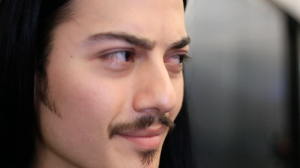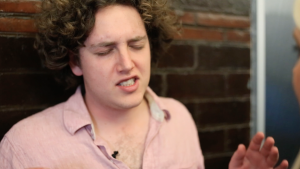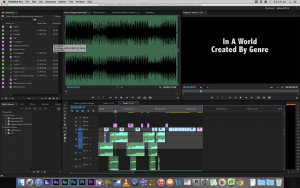This was originally going in my previous post about the first day of production however it was getting a bit too long and I feel that this could be an interesting post on its own. As I mentioned previous there are things that i’ve picked up during my experience of shooting, things that you can only really learn or appreciate once you’ve gone through it.
First thing is sound:
I wasn’t too sure on the whole sound set up we had. Because we were shooting on a DSLR we had to record the sound separately, which is fine, as long as your prepared for it. By this I mean you need to make it easy for yourself in post production by writing the roll or the file number on the clapper so that when you’re looking at the footage you can easily navigate to the correct audio file without having to go through and listen to them all, which you can imagine is pretty time consuming (and yes I found this out the hard way, editing my own footage without listing the roll on the clapper just meant I had to open up and listen to every clip, it was a nightmare!). And I did mention that at the start of our shoot, I said that it would make life so much easier, however after a few shots in in turned out we were writing down the wrong number for the roll, I insisted finding the right roll and writing it down on the clapper however everyone seemed to think that it would be fine and we can deal with it later. The said as long as it was in order we could find it pretty easily, which I hope is true but I have a suspicion that it might not, it might become this arduous task that could’ve been avoided.
The other problem I had with sound were the microphones that we were using, we had lapel mic’s on all of the actors plus a boom plus an omni on the actual recorder, we were using a H6 I think. In my opinion: we could’ve done without the lapel mic’s, I would’ve just had a boom mic and the omni as a back up. A few problems that I’ve found with Lapel mic’s which became evident on the shoot were they always get in the way, it’s hard to shoot, especially with the actors and camera moving around so much, without showing the mic on the actor. The next thing is because they’re wireless they’re prone to interference which also became evident on our shoot. I think we went overkill with the microphones that we used, I know it doesn’t hurt having them because you have backups but it just makes thing that more difficult when you put it on top of the problem I mentioned about not writing the role down and having to listen to all the audio clips in post, the more clips you record the more you have to syphon through.
The other problem I wanted to mentioned was the camera:
The camera that we decided to use for our shoot was a DSLR Canon D6. I don’t have a problem shooting on a DSLR, in fact that’s what I normally use however there are things I’ve learned to look out for when using one. I kind of new the problems that we might have as soon as we picked up the equipment. First of all, if your shooting hand held (which was one of our major stylistic elements) on a DSLR you need to mount it to a rig, anything like a shoulder rig or glide cam, the camera is two small and it’s unstable when holding it by the body with your hands, there is just too much movement. evidently I feel like a lot of our shots are going to be extremely shaky, not sure how much of it we can fix in post.
The other thing with DSLR’s is their lenses create a very shallow depth of field. The lens that we were using was a 50mm static lens at f/1.4 or 1.8, the problem with this is it makes it really difficult to keep a subject in focus when their moving back an forwards in frame. For instance when our character Vincent was stumbling down the hallway, if the focus wasn’t pulled correctly then the whole shot would be wasted, even if everything else went well. A few ways I would suggest to fix this problem is to attach a follow focus to the lens, this means you can actually mark out the focus pull, increasing you strike rate exponentially. Other ways that would’ve helped is an external monitor: this helps because you can see the screen more clearer as its bigger than the small on on the screen or in the view finder and most external monitors have zebra stripes for peaking and focus.
Anyway, these are just a few things that I noticed during our shoot which might come bach to haunt us in post production. but I guess we will wait and see!


